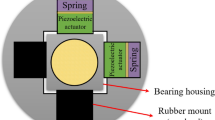Abstract
Rotor active magnetic bearing (rotor-AMB) systems are frequently used to alleviate vibrations for various applications such as in national defense, manufacturing industries, IC production, and aerospace engineering. One obstacle to improve machining efficiency and quality is the open-loop instability of rotor-AMB systems during the machining process. We built a closed-loop processing platform using a spindle rotor installed with AMBs and thereby developed a rotor-AMB suspension system embedded with a dual-mode predictive controller (DMPC). The performance of the system is thus substantially improved. In the proposed DMPC, both model-based prediction and receding horizon optimization are utilized to guarantee the closed-loop stability of the rotor-AMB suspension systems with input constraints. Finally, the effectiveness and superiority of the proposed method are examined through substantial levitation experiments on a machining platform with installed AMBs.
Similar content being viewed by others
References
Knospe C R. Active magnetic bearings for machining applications. Control Eng Pract, 2007, 15: 307–313
Lim T M, Zhang D, Yang J, et al. Design and parameter estimation of hybrid magnetic bearings for blood pump applications. Mech Syst Signal Process, 2009, 23: 2352–2382
Fittro R L, Knospe C R. μ control of a high speed spindle thrust magnetic bearing. In: Proceedings of IEEE International Conference on Control Applications, 1999. 570–575
Zhang L, Liu K. Riccati difference equation in optimal control for magnetic bearings. Sci China Technol Sci, 2012, 55: 2107–2114
Schweitzer G, Maslen E H. Magnetic Bearings: Theory, Design, and Application to Rotating Machinery. Berlin: Springer, 2009
Maslen E H, Sawicki J T. μ-synthesis for magnetic bearings: why use such a complicated tool? In: Proceedings of ASME 2007 International Mechanical Engineering Congress and Exposition, 2007. 1103–1112
Sivrioglu S. Adaptive control of nonlinear zero-bias current magnetic bearing system. Nonlinear Dyn, 2007, 48: 175–184
Kang M S, Lyou J, Lee J K. Sliding mode control for an active magnetic bearing system subject to base motion. Mechatronics, 2010, 20: 171–178
Kuseyri I S. Robust control and unbalance compensation of rotor/active magnetic bearing systems. J Vib Control, 2012, 18: 817–832
Dong L L, You S L. Adaptive control of an active magnetic bearing with external disturbance. ISA Trans, 2014, 53: 1410–1419
Pesch A H, Smirnov A, Pyrhonen O, et al. Magnetic bearing spindle tool tracking through μ-synthesis robust control. IEEE/ASME Trans Mechatron, 2015, 20: 1448–1457
Kandil M S, Dubois M R, Bakay L S, et al. Application of second-order sliding-mode concepts to active magnetic bearings. IEEE Trans Ind Electron, 2018, 65: 855–864
Xie J, Zeng X J, Zhang M M, et al. Implementation of active magnetic control system for piston centering in labyrinth piston compressor. Mechatronics, 2018, 54: 52–67
Chen M, Wu Q X, Jiang C S, et al. Guaranteed transient performance based control with input saturation for near space vehicles. Sci China Inf Sci, 2014, 57: 052204
Chen M, Ren B B, Wu Q X, et al. Anti-disturbance control of hypersonic flight vehicles with input saturation using disturbance observer. Sci China Inf Sci, 2015, 58: 070202
Albin T. Benefits of model predictive control for gasoline airpath control. Sci China Inf Sci, 2018, 61: 070204
Harinath E, Foguth L C, Braatz R D. A robust dual-mode MPC approach to ensuring critical quality attributes in quality-by-design. In: Proceedings of American Control Conference (ACC), 2016. 2041–2046
Yuan Y, Zhang H T, Wu Y, et al. Bayesian learning-based model-predictive vibration control for thin-walled workpiece machining processes. IEEE/ASME Trans Mechatron, 2017, 22: 509–520
Cai Z, Haq A A U, Cholette M E, et al. Energy efficiency and tracking performance evaluation for dual-mode model predictive control of HVAC systems. J Thermal Sci Eng Appl, 2018, 10: 041023
Maciejowski J M. Predictive Control: With Constraints. Englewood Cliffs: Prentice Hall, 2002
Ruan X G, Hou X Y, Ma H Y. Stability analysis of constrained MPC with CLF applied to discrete-time nonlinear system. Sci China Inf Sci, 2014, 57: 112201
Zhang Y Y, Cao W H, Jin Y L, et al. An ensemble model based on weighted support vector regression and its application in annealing heating process. Sci China Inf Sci, 2019, 62: 049202
Mayne D Q, Rawlings J B, Rao C V, et al. Constrained model predictive control: stability and optimality. Automatica, 2000, 36: 789–814
Guo L L, Gao B Z, Li Y, et al. A fast algorithm for nonlinear model predictive control applied to HEV energy management systems. Sci China Inf Sci, 2017, 60: 092201
Zhang H, Wang T, Zhao Y L. FIR system identification with set-valued and precise observations from multiple sensors. Sci China Inf Sci, 2019, 62: 052203
Zhang H T, Wu Y, He D, et al. Model predictive control to mitigate chatters in milling processes with input constraints. Int J Mach Tools Manu, 2015, 91: 54–61
Kouvaritakis B, Rossiter J A, Schuurmans J. Efficient robust predictive control. IEEE Trans Autom Control, 2000, 45: 1545–1549
Zhang H T, Li H X, Chen G. Dual-mode predictive control algorithm for constrained Hammerstein systems. Int J Control, 2008, 81: 1609–1625
Khalil H K. Nonlinear Systems. Englewood Cliffs: Prentice Hall, 2012
Zhang H T, Chen G, Chen M Z Q. A novel dual-mode predictive control strategy for constrained Wiener systems. Int J Robust Nonlinear Control, 2009, 20: 975–986
Zhang F Z. The Schur Complement and Its Applications. Berlin: Springer, 2006
Lofberg J. YALMIP: a toolbox for modeling and optimization in matlab. In: Proceedings of IEEE International Conference on Robotics and Automation, 2004. 3753–3757
Blondel V D, Boyd S P, Kimura H. Recent Advances in Learning and Control. Berlin: Springer, 2008
Acknowledgements
This work was supported by National Natural Science Foundation of China (Grant Nos. U1713203, 61803168, 51729501) and China Postdoctoral Science Foundation (Grant No. 2018M642822).
Author information
Authors and Affiliations
Corresponding author
Rights and permissions
About this article
Cite this article
Wu, Y., Ren, GP. & Zhang, HT. Dual-mode predictive control of a rotor suspension system. Sci. China Inf. Sci. 63, 112204 (2020). https://doi.org/10.1007/s11432-019-9896-2
Received:
Revised:
Accepted:
Published:
DOI: https://doi.org/10.1007/s11432-019-9896-2




